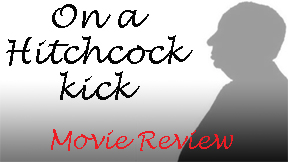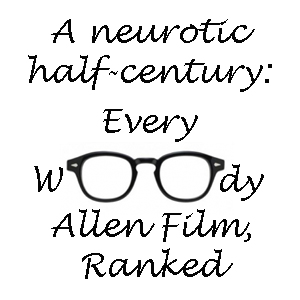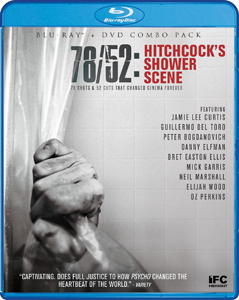If the shower scene – or should I say The Shower Scene – from Alfred Hitchcock’s “Psycho” (1960) wasn’t already the most obsessively analyzed sequence in film history, the documentary “78/52” (1917) clinches the status as it examines the artistry and cultural impact. Writer-director Alexandre O. Philippe’s documentary is as engrossing as a Hitchcock film, trading out suspense for sharp analysis.
Water pressure
A key element that marks a good documentary is balance, and “78/52” – named after The Shower Scene’s 78 camera setups and 52 cuts – has that. At one extreme, actors and crew people from the film world marvel at the genius of it, as we see them watching on a mocked-up old circle-screened TV. (Furthering the aesthetic, the docu is shot in black and white.)
At the other extreme, some interviewees find points to criticize. One expert is disappointed that the silhouette of Norman’s mom (played by a stuntwoman, not Anthony Perkins, we learn) gives her a mushroom-shaped haircut. Another points out that a quick cut back to the shower nozzle – away from the fresh corpse of Marion Crane (Janet Leigh) — is an error-covering shot. (Leigh had taken a breath, and Hitch used this workaround.)

“78/52: Hitchcock’s Shower Scene” (2017)
Director: Alexandre O. Philippe
Writer: Alexandre O. Philippe
Part of the docu analyzes the setup and editing choices obsessively, but take heart that this is only about 20 percent of the runtime. “78/52” is accessible to even casual viewers as it puts “Psycho” and The Shower Scene into the contexts of film history and Hitchcock’s career. While this might’ve been his first pure horror film, it’s interesting to spot proto-Shower Scenes going as far back as “The Lodger” (1927), wherein a woman is taking a bath as a potential killer lurks outside the door.
Philippe uses sharp observations from Hitch biographers and film folks (ranging from Eli Roth to Elijah Wood) to paint the timeline. He illustrates how cinematic art and censorship were at a certain point pre-“Psycho” (famously, it was taboo to show toilets on screen) and another point post-“Psycho.” A striking still image shows 1960 filmgoers’ shocked reactions to seeing a woman murdered in that safest of sanctuaries. Noted Hitch fan Peter Bogdanovich starkly sums up a common reaction: Exiting the theater after his first viewing, he felt like a rape victim.
For further study
“78/52” raises a few fascinating issues it could’ve dug into further:
- “Psycho” editor George Tomasini (1909-64) is mentioned a lot, but the docu doesn’t go into his life. And it only gives a cursory nod to the complex, physical process of cutting and taping that was editing in the midcentury. On the plus side, the masterful choices of composer Bernard Herrmann are analyzed, and the influence on future horror cues – from “Jaws” to slashers – is acknowledged.
- Speaking of editors, “Psycho” 1998 editor Amy Duddleston is interviewed, and fascinatingly, she believes the version crafted by herself and director Gus Van Sant, with Anne Heche playing Marion, is ineffective. Duddleston suggests it never could be – even though the stated goal of the remake was to copy the original. It might’ve been neat to probe why that is. It’s not wholly because of the Van Santian inserts of storm clouds representing Marion’s mind, since those frames were added later in the process as part of the salvage attempt. (This video provides a side-by-side comparison, if you want to form some guesses. One thing jumps out: The 1998 sequence is longer.)
- While the docu shows many of the parodies of The Shower Scene, it doesn’t emphasize an interesting point. While many post-“Psycho” horror films feature the attractive female protagonist taking a shower, those scene often have no narrative purpose. Very few horror films have attempted to do their requisite shower scene like The Shower Scene. Even “Bates Motel” Season 5 (which shot simultaneously with this docu, thus explaining it going unreferenced) – featuring Rihanna as Marion Crane – merely used our knowledge of the “Psycho” narrative as a fake-out. The TV show seemingly heeded Duddleston’s warning.
Shower (Scene) power
The notion of a shower scene merely building a mood (making us think of the protagonist in a vulnerable state, even if they’ll certainly survive the scene itself) is a direct contrast to “Psycho.” Hitch was not one to waste frames merely building a mood but not advancing the story.

Indeed, the Shower Scene might be his most in-your-face example of shaking up the narrative, as it marks a total handoff from one main character to another. The documentary goes so far as to lightly contend that “Psycho” might be mediocre except for this scene. The scene is so good, the argument goes, that it elevates everything else and makes us overlook “Psycho’s” flaws.
It’s interesting to think about how “Psycho’s” success was both planned and accidental. Fascinatingly, Hitchcock at one point had such low hopes for the box-office prospects that he considered cutting it down into a 1-hour “Alfred Hitchcock Presents” episode. On the other hand, this scene was the reason he wanted to make the movie. The most meticulous storyboarding and screenwriting is reserved for The Shower Scene.
Hitchcock spent four days shooting it, getting it as close to perfect as he could. Hitch wasn’t a perfectionist overall, but he had a good sense of what part(s) of a movie needed to be effective in order to achieve overall success.
Speaking of successes, “78/52” is one. It justifies its obsession by illustrating why this scene deserves to be obsessed over. While we may safely assume we won’t be attacked by a knife-wielding psychopath while showering, “Psycho” taught us that the odds are never zero. Next time you are alone in your locked living quarters and you nonetheless close and lock your bathroom door, reflect for a moment if “Psycho” has anything to do with that.
RFMC’s Alfred Hitchcock series reviews works by the Master of Suspense, plus remakes and source material. Click here to visit our Hitchcock Zone.

